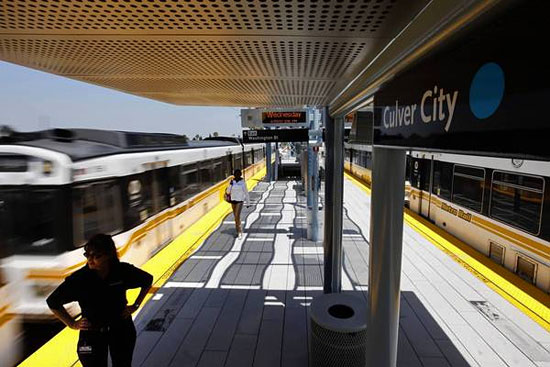Gate latching hits a roadblock
September 26, 2013

Elevated light rail stations, like in Culver City, are among the next targets for latching. Photo/L.A. Times
L.A.’s subway system has locked its gates and finally moved past an honor system that’s been in place for more than two decades. But it’s a different story at dozens of Metro light rail stations, which usually have stand-alone fare-card readers but no barriers to entry.
David Sutton, Metro’s deputy executive officer in charge of the gate-latching project, said that won’t change any time soon. Last week, in response to a July motion from several members of the Board of Directors, Sutton and his team released a report on the feasibility of installing lockable turnstiles on Phase 1 of Expo Line and at future stations throughout the expanding rail system.
“We’re not going to be able to lock them all,” Sutton said. “Some of the stations just don’t lend themselves to gates because of the space available and the cost.”
The primary reason is safety, said Rick Meade, who manages station construction for the agency. The National Fire Protection Association requires safe evacuation of platforms within 4 minutes in case of an emergency, as well as clearance to a “safe distance” within 6 minutes.
“As soon as you put gates on there, your exiting calculations are going to change because you have an obstruction that slows everything else down,” Meade said. Underground and aerial stations have space to accommodate enough gates for a swift exit, he said, but street-level stations usually do not. For those, increasing the size of platforms is often the only solution, a costly proposition that can encroach on traffic lanes or other property.
Some stations on the light rail system are already equipped with turnstiles, and their latching is slated for completion by February, Sutton said. On the Gold Line, the 5 out of 21 stations with turnstiles were latched earlier this month. Next up is the Blue Line, where 6 of 21 stations are scheduled to be latched in December, followed by all 14 stations of the elevated Green Line.
Along all Metro’s light rail routes, there currently are 41 stations where customers can enter without a barrier requiring payment, including the entire first phase of Expo Line. Sutton and his team examined the possibility of installing barriers at all non-gated light rail stations and have identified 13 for further analysis.
For Expo’s first phase, Metro estimates it would cost $3.1 million to add gates to three elevated stations, an investment the agency says could be recouped within 7 years because of increased fare collection. At the street-level stations, where there’s no room for gates, Metro is planning to add more stand-alone card validators at a cost of $173,000, plus $141,000 in annual operating expenses. Sutton said the non-gated card readers have been effective elsewhere in the system in reminding riders who want to comply with the rules to tap their fare cards.
“With gates and these kinds of things, it keeps honest people honest,” Sutton said.
Sutton said he plans to return to Metro’s Board of Directors in January with a full engineering analysis of what would be needed to install gates and additional card validators on Expo’s first phase, which goes from downtown to Culver City.
A similar gating scenario is being faced by Expo’s second phase, which will end in Santa Monica and is now under construction. At least two of the seven stations in that phase could not have locked gates, while four others are able to accommodate barriers and one other is being reviewed. For future rail projects that have yet to be designed or constructed, lockable gates will be required, Sutton said.
Meanwhile, on the Red and Purple lines, where gates have already been latched, preliminary data on fare collection for August is encouraging, showing a 22% increase in ticket machine sales over the same month last year—worth more than $614,000. Sutton said many free riders have left the system, opening more seats for paying customers.
The latched stations have also been a help to law enforcement, said Lieutenant Sergio Aloma, a transit services officer with the Los Angeles Sheriff’s Department, which is tasked with policing the system.
“Any time you can latch stations, it is better from a fare enforcement standpoint,” Aloma said. “I just wish we could latch them all.”
Aloma said latching even some gates allows officers to be deployed in larger numbers to non-gated locations. The increased visibility of law enforcement, he said, works as a deterrent to would-be fare evaders.
Aloma also said that, even at stations where gates are locked, dedicated scofflaws will find ways to beat the system by, for example, sneaking through access points for disabled people or jumping turnstiles. On the other hand, some riders may make honest mistakes such as forgetting to tap their fare cards when transferring lines as they try to figure out the new system.
“In some cases deputies have to use discretion and determine whether we need to take a customer-relations viewpoint or an enforcement viewpoint,” Aloma said. “This is still new and we want to educate folks on how to use the system.”
Posted 9/26/13












 405 bridge work causes a stink
405 bridge work causes a stink

